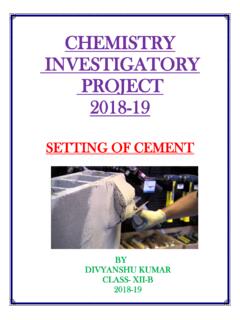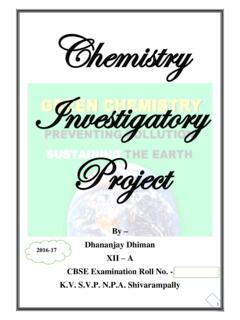Transcription of NCERT
1 PROJECTSBACKGROUND INFORMATIONABOUT investigatory PROJECTSINTRODUCTIONThe expansion of scientific knowledge and consequently the change in the systemof education has led to a modification in the methods of instruction. Today thestress is laid on inquiry approach and discussion method instead of the age-oldlecture method of teaching. A new dimension in the teaching of science has beenadded by including the project -work at the higher secondary level. Teachingthrough project work is an individualized instructional technique. It provides anopportunity to the student to define a problem, to plan his/her work, to searchappropriate resources, to carry out his/her plans, and to draw conclusions. Thisway, students are exposed to the fundamental scientific principles, methods andprocesses and get a first hand knowledge about the various phases involved in ascientific investigation.
2 Thus the project work helps to: (a) stimulate interest inscience; (b) arouse scientific curiosity; (c) develop independent critical thinking;(d) provide experience of using various tools and techniques in the field of scienceand (e) develop self-confidence. The modern trend in the teaching of sciencetherefore encourages more project kind of investigation; formulated, designed and carried out in the library,laboratory, in the field, or at home constitutes an investigatory project . A projectmay be as simple as collection of samples of minerals and it may be as difficult asdeveloping an original indigenous process for the production of a chemical. Someof the projects can be completely theoretical and involve only the library may involve the experimental work to be carried out in the experimental work in science exposes the students to a number of scientificinstruments, tools, techniques and intellectual OF PROJECTSP rojects should usually be selected by the students.
3 The idea of a project originatesfrom studying a subject in the classroom, reading the reports of various projects,science news, popular science articles from science journals etc. Sometimes theidea of a science project may strike during classroom discussion on topics, whichmay require testing, quantifying and interpreting. Some of the science journalsfor getting the ideas for a project are : (a) Journal of Chemical Education;(b) Chemistry Education; (c) Education in Chemistry; (d) New Scientist; (e) SchoolBACKGROUND INFORMATION ABOUT investigatory PROJECTS123 Science; (f) School Science Review; (g) Science; (h) ScientificAmerican; (i) School Science Resource Letter, etc. Once the projectwork begins, it might provide new titles and spite of the availability of the above listed scientific literature,it should not be assumed that students can begin the work onprojects spontaneously.
4 Since majority of the science journals listedabove are not available in Indian Schools. Students need the helpand guidance from the teacher. If some student does not get anidea for the project , the teacher may provide a list of suggestedprojected or take the students to science fairs and exhibitions toshow what other students are doing. A format for working on theprojects is given of and importance of brief outline of work on ProjectThe title of the project should be written in such a manner thatthe objectives and importance of the project is clearly defined. Inother words a project title and its objectives should create aninterest and curiosity. A brief outline of working on a project helpsthe student to initiate the may be debatable that this approach of suggesting ideas forthe projects defeats one of the basic objectives of project work,namely originality, but providing guidelines to the students iscompletely scientific and desirable to encourage every student tobegin and aim at something in the first TIMEC entral Board of Secondary Education has allocated ten periodsfor the project work.
5 A student can start the project right in thebeginning of the academic year and can carry it out in phases andsubmit the report of the project at the end of the AND ACADEMIC GUIDANCEThis is an important factor in the smooth running of the projectwork. The student should plan for the project well in advance anddiscuss its design with the teacher. If improvisation of the apparatusor some instrument is needed or a chemical is not available in thelaboratory. The help of teacher may be taken. If some technical oracademic guidance is required help may be taken not only fromthe concerned teacher of chemistry but also from physics fromand other science teachers as MANUAL CHEMISTRYLABORATORY FACILITIESThe selection of the project should be such that as far as possible,the material (apparatus, instruments, chemicals, etc.) needed forthe project -work is easily available.
6 Student may purchase theaffordable chemical or an apparatus (improvised or original) if it isnot available in the laboratory, and the student is very curious totake up the project and wants to do it. The students should bediscouraged from taking highly expensive projects. An effectiveproject-work requires an integrated approach rather than a subjectspecific project work in the laboratory requires a bigger and separatespace. Arrangements should be made in such a way that at a giventime all the students are not involved in doing the laboratory students should carry out the work of collecting references inthe library while others should design may arise in carrying out the long term experimentslike corrosion, fermentation etc. in the laboratory. It is suggestedto have a separate bench in the laboratory, where long termexperiments can be set up.
7 For storing the samples of certainchemicals and apparatuses relevant to the project -work, card-board boxes, with student s name written on them can be bottles, if available, can also serve the purpose of storingthe THE project WORKR ecording the actual observation in the project work is veryessential. Students should be encouraged to record the negativeresults also. A general format for writing the project report issuggested below. It should involve the following points of project reflecting used for and Chemicals , if and and the logic upon which the conclusions for further investigations, if anyTo illustrate the format outlined above, a sample project report is presented in the end. It may further be noted thatsample project report serves merely as a guideline to theBACKGROUND INFORMATION ABOUT investigatory PROJECTS125students while writing their projects.
8 It is by no meansexhaustive and is open to further improvements. Briefoutline of some projects is given 1 TitleTo test the contamination of water by bacteria by checking thesulphide ion concentration and find out the cause of check the bacterial contamination in samples of water collectedfrom different sources by determining sulphide ion InformationSulphide ions are present in water when anaerobic bacteriadecompose organic matter or reduce sulphates. These are foundin stagnent water. Generally pollutants from paper mills, gas works,tanneries, sewage works and other chemical plants are responsiblefor the growth of such ProcedureCollection of SamplesSulphides are readily oxidised, therefore care should be taken atthe time of sampling to exclude air by flushing it with nitrogen orcarbon dioxide. But the best way is to fix the sample immediatelyafter collection.
9 This can be done by adding small volume ofcadmium-zinc acetate solution. For this take 80 mL of water andadd cadmium-zinc acetate solution 20 mL to obtain a total volumeof about 100 mL. To make Cd-Zn acetate solution dissolve 50 gcadmium acetate and 50 g zinc acetate in L of water. If collectedsample is acidic in nature, then first neutralize it with little excessof of Fixed SolutionTake 100 mL fixed solution in a titration flask, add 20 mL Miodine solution and immediately add 15 mL, (1:1) HCl and mix. Titratethe excess iodine against M Na2S2O3, adding starch solutionas indicateor towards the end point. Calculate the amount ofsulphide ions in the original samples from the amount of iodineused in the reaction with H2S. Subtract the values of blank titrationif available from the calculated MANUAL CHEMISTRYPROJECT 2 TitleTo study the methods of purification of To study level of purity achieved by using different methodsof purification.
10 To study advantages and disadvantages of using differentmethod for purification. To know about specific uses of pure InformationPurity of water obtained from different natural sources is type of contamination and impurity present depends uponthe source from which water is obtained. Besides drinkingpurposes, we require pure water for various other purposes chemical analysis. There are various methods for the purificationof water. these remove impurities and contamination to differentextent. There are some advantages and disadvantages in usingthese methods. Comparison of various methods of purification willprovide an idea about obtaining water of specific purity for aspecific ProcedureStudents may find out level of puriety achieved by varioustechniques in use, for the purification of drinking water. They cansurvey the literature and visit industries etc.










![[CLASS XII CHEMISTRY PRACTICALS] - Saint John's Senior ...](/cache/preview/8/e/c/c/7/0/2/b/thumb-8ecc702b441a6099d9810dbf9f2c3c2f.jpg)


